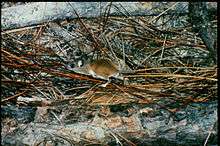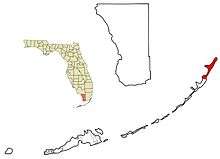Key Largo cotton mouse
| Key Largo cotton mouse | |
|---|---|
 | |
| Scientific classification | |
| Kingdom: | Animalia |
| Phylum: | Chordata |
| Class: | Mammalia |
| Order: | Rodentia |
| Family: | Cricetidae |
| Genus: | Peromyscus |
| Species: | P. gossypinus |
| Subspecies: | P. g. allapaticola |
| Trinomial name | |
| Peromyscus gossypinus allapaticola Schwartz, 1952 | |
The Key Largo Cotton Mouse (Peromyscus gossypinus allapaticola) a subspecies of the Cotton mouse (Peromyscus gossypinus), is a slightly larger mouse with a more reddish color than other subspecies of cotton mice from peninsular Florida.[1] Because of habitat destruction, the Key Largo cotton mouse is restricted to the northernmost portion of Key Largo, Florida, in the United States. It is currently on the United States Fish and Wildlife Service list of endangered species. This cotton mouse subspecies can reach a body length of seven inches (17.9 centimeters) with a tail length of three inches (7.7 centimeters). Key Largo cotton mice have a dark hazel back with reddish brown sides, a white belly, white feet, and a tail that is brown on top and white on the bottom.[1]
Taxonomy
Due to its longer overall length, tail length, skull measurements and reddish fur color, the Key Largo cotton mouse was described as a distinct subspecies by Schwartz in the year 1952.[2] Its name allapaticola originates from the local Seminole Native American term allapattah which stands for the tropical dry deciduous hammocks of South Florida.[3]
Distribution

Both the Key Largo cotton mouse and the Key Largo woodrat are endemic to Key Largo, Florida. Due to habitat destruction from development and fires, the Key Largo cotton mouse has been pushed to the furthest most portion of Key Largo, North Key Largo. Although historically the Key Largo cotton mouse was once found as far south as Plantation Key, near Taverniernorth, they are now only found in a confined area north of the U.S. 1-C.R. 905 intersection.[1]
Habitat
Like previously mentioned, because of increasing human activity and population, the Key Largo cotton mouse's distribution is limited to North Key Largo. In addition to being only found in this small area, the Key Largo cotton mouse's preferred habitat is coastal strands adjacent to these forests. Canopy trees of this North Key Largo area include black ironwood (Krugiodendron ferreum), gumbo limbo (Bursera simaruba), Jamaican dogwood (Piscidia piscipula), mahogany (Swietenia mahagoni), pigeon plum (Coccoloba diversifolia), poisonwood (Metopium toxiferum), strangler fig (Ficus aurea), and wild tamarind (Lysiloma latisiliquum). Hammock understory contains torchwood (Amyris elemifera), milkbark (Drypetes diversifolia), wild coffee (Psychotria nervosa), marlberry (Ardisia escallonioides), stoppers (Eugenia spp.), soldierwood (Colubrina elliptica), crabwood (Gymnanthes lucida), and velvetseed (Guettarda scabra).[4] Ground cover contains cheese shrub (Morinda royoc) and snowberry (Chiococca alba).[4]
Behavior
Because there is such a small population of Key Largo cotton mice, much of the behavioral characteristics are inferred from the cotton mouse. The Key Largo cotton mouse builds small nests or dens by lining leaves inside logs, tree hallows, and rock crevices. The entrances to these nests measure around 3 to 9 cm in diameter and are oftentimes located at the base of trees; however, there are some instances where there is an interesting relationship in that the Key Largo cotton mouse will share a nest with another endangered species, the Key Largo woodrat.[1]
Conservation
The Key Largo cotton mouse was recognized by the Fish and Wildlife Service in a notice of review on July 28, 1980 (45 FR 49961). It was listed as endangered for 240 days on September 21, 1983, through an emergency listing action (48 FR 43040).The Key Largo cotton mouse was proposed as endangered with critical habitat on February 9, 1984 (49FR 4951) and was listed as an endangered species on August 31, 1984 (49 FR 34504).[1] Urbanization has caused much of the decline in species population and because of this there have been a number of efforts to try to reestablish population in less urbanized areas of the Florida Key's; however success is very limited. In the past, very little research focused primarily on the Key Largo cotton mouse and additional information about this species is needed. Density and distribution studies of the Key Largo cotton mouse have been conducted, but the status of the current population is not known.[3]
References
- 1 2 3 4 5 "Key Largo Cotton Mouse" (PDF). Fish & Wildlife Service. Retrieved 2013-12-05.
- ↑ "and Plants; Proposed Endangered Status and Critical Habitat for the Key Largo Woodrat and Key Largo Cotton Mouse" (PDF). Federal Register. 28. 49: 4951. February 9, 1984. Retrieved 8 December 2013.
- 1 2 Barbour, D. Bruce; Stephen R. Humphrey (Feb 1982). "Status and Habitat of the Key Largo Woodrat and Cotton Mouse (Neotoma floridana smalli and Peromyscus gossypinus allapaticola)". Journal of Mammalogy. 63: 144–148. doi:10.2307/1380680. JSTOR 1380680.
- 1 2 .
Goodyear, N.C. 1985. Results of a study of Key Largo woodrats and cotton mice: Phase I, spring and summer 1985. Unpublished report to North Key Largo Study Committee.
Missing or empty|title=(help);
